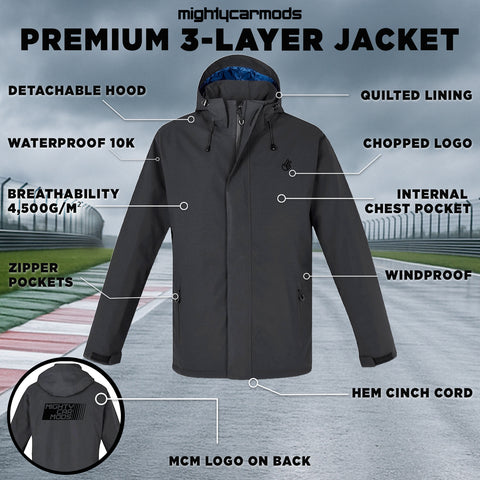
Unstuck yourself - removing rusted or stubborn bolts, nuts and screws
If you work on your car yourself you're probably going to eventually come up against a bolt or nut that simply does not want to come out. Workshop Manuel loves his massive old American cars (and Subarus and E30 BMWs, tragically), and has spent many a day/night fighting stubborn bolts so here are some of his top tips on removing bolts and nuts which do not want to budge.

Firstly, check the old "righty-tighty, lefty-loosey" method and make sure you have a can of penetrating spray like the WD40 Our Friend Martin here is modelling. Have a bo peep under your car at all the bolts you need to undo and clean any grease or schmutz off them before giving each one a quick squirt with the spray 5-10minutes before you need to undo them. This gives the spray time to bite into the rust and crustiness.

In THIS video MOOG shows the correct technique for spraying chemicals under a car - wear eye protection, kids! I'd also advise you should grab some black nitrile gloves when you're dealing with rusty bolts as they let you feel how the bolt is going, but still protect your fingers.

Check what tool you're using, as sometimes there is a better one to use as it will grip the bolt or nut more securely and turn it without risk of rounding it off. Open-end spanners (or wrenches, for our American homies) don't provide as much secure leverage as a ring spanner, or a socket. Don't ever use an adjustable wrench except as a hammer or a wheel-chock because they are nearly guaranteed to slip and round-off any fastener you're trying to undo. They suck.

If your rachet isn't doing the job, try increasing the leverage on the bolt or nut. A breaker bar uses the length to increase twisting forces (torque) to crack the fitting loose. These are super-handy additions for any toolbox if you love working on mad of nuggets.

When it comes to getting torque through a bolt there are different sized sockets you can use. Both these sockets are 16mm but the one on the left is "half-inch-drive" and the one on the right is "3/8ths-drive". The larger the drive, the more torque you can put through the stuck bolt or nut, and torque is what undoes fittings. 3/8 and 1/2in are the most common but there is the smaller quarter-drive for tight spaces and the huge three-quarter-drive and one-inch which are often used on heavy industrial equipment, trucks and large vehicles.
 Sockets aren't all made equal - there are bi-hex and singe-hex variations - and for stuck fasteners the single-hex are the Vegemite to your toast... the beer to your BBQ... the goat to your MCM vid! They grip more securely onto the head of the fastener you're trying to remove, reducing the liklihood of it rounding and allowing you to really swing off it (just be careful not to snap it, remember that penetrating oil!).
Sockets aren't all made equal - there are bi-hex and singe-hex variations - and for stuck fasteners the single-hex are the Vegemite to your toast... the beer to your BBQ... the goat to your MCM vid! They grip more securely onto the head of the fastener you're trying to remove, reducing the liklihood of it rounding and allowing you to really swing off it (just be careful not to snap it, remember that penetrating oil!).

If the bolt or nut is really stuck-fast there are a few tricks you can use to undo them. First, double-check you're not dealing with a reverse-thread fastener but giving a coupe of right-hand hits. Don't apply too much pressure in one go, but if the bolt moves you might be able to rock it loose by moving it right, then left.
If you can't get a nice, long breaker bar onto the bolt or nut to really hang off it, then you might be able to join 2 spanners together like Marty did HERE in the epic video showing 250 awesome tips and tricks.

"Crow's Feet" spanners are a must-have if you ever need to undo brake hardline fittings. These offer more grip on the head of the bolt or nut, which means you can put more oomph into undoing it.

Screws in old cars often get stuck, like the two big Phillips Head screws holding Workshop Manuel's Pontiac's quarter-windows together. One great trick is to find a screwdriver that fits snugly into the head of the screw, then get a mallet and hit the end of the handle to really ram the tip of the screwdriver securely into the screw. Workshop Manuel also has a screwdriver with a hex-fitting on the shank so he can use the spanner to increase torque on the screw to make it easier to undo.

Several companies sell freeze spray which uses science to slightly shrink the metal in a bolt. Remember high school? (Nah, me either) but metal shrinks when it gets super-cold, and expands when it is heated, so the theory behind using freeze-sprays (or a torch to heat a fastener) is this process will break the bonds holding the fastener in place as the bolt shrinks (cooling) or the nut expands (heating).

Keep an eye on the MCM website because I'll walk you through removing cross-threaded and snapped fasteners next time, and how to fix the mess they leave behind!

![Limited Edition Budget Street Cred Golf [AUTOGRAPHED]](http://mightycarmods.com/cdn/shop/files/FullSizeRender_480x480.jpg?v=1760910149)
![Boosty Boi T-Shirt [Black Edition]](http://mightycarmods.com/cdn/shop/files/DSC2662_b504777a-ecdc-4da2-8b18-b4b525bce4d5_480x480.jpg?v=1759355323)
![Chopped MCM Hoodie [Black Edition]](http://mightycarmods.com/cdn/shop/files/DSC2445_d41795ae-8f15-4257-8ae2-60623a893824_480x480.jpg?v=1759099951)
